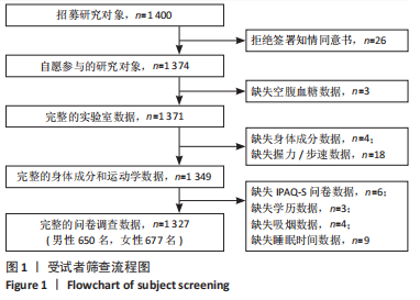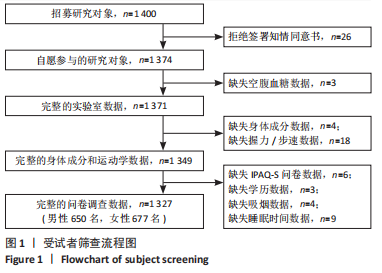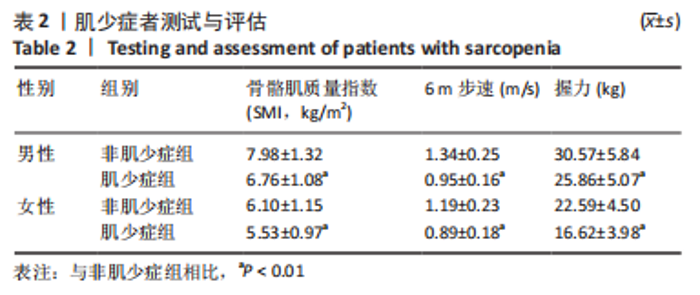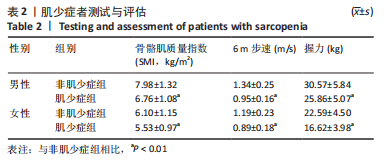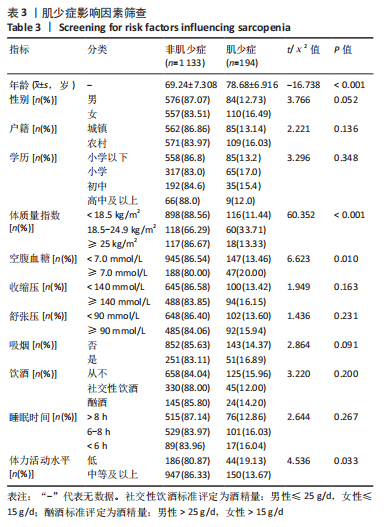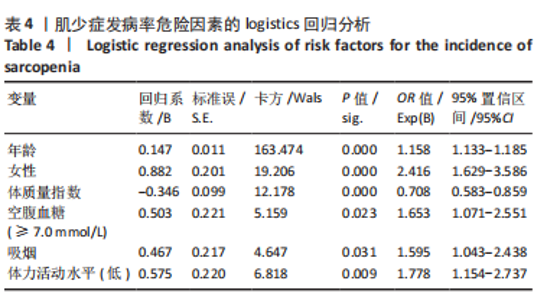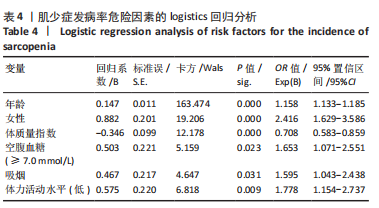[1] JUBY AG. A healthy body habitus is more than just a normal BMI: implications of sarcopenia and sarcopenic obesity. Maturitas. 2014; 78(4):243-244.
[2] PETERMANN-ROCHA F, BALNTZI V, GRAY SR, et al. Global prevalence of sarcopenia and severe sarcopenia: a systematic review and meta-analysis. J Cachexia Sarcopenia Muscle. 2022;13(1):86-99.
[3] CHEN LK, WOO J, ASSANTACHAI P, et al. Asian Working Group for Sarcopenia: 2019 Consensus Update on Sarcopenia Diagnosis and Treatment. J Am Med Dir Assoc. 2020;21(3):300-307.
[4] 孟欣宇,赵文静,张金华,等. 社区老年人身体活动与罹患肌少症的关联[J]. 中华疾病控制杂志,2020,24(8):914-918.
[5] 王慧,海珊,刘颖,等. 成都市社区老人肌少症患病率及相关因素研究[J]. 四川大学学报(医学版),2019,50(2):224-228.
[6] FU R, SUN Y, ZHAI J, et al. Dietary patterns and sarcopenia in a Chinese population. Asia Pac J Clin Nutr. 2021;30(2):245-252.
[7] XIA MF, CHEN LY, WU L, et al. Sarcopenia, sarcopenic overweight/obesity and risk of cardiovascular disease and cardiac arrhythmia: A cross-sectional study. Clin Nutr. 2021;40(2):571-580.
[8] WU LC, KAO HH, CHEN HJ, et al. Preliminary screening for sarcopenia and related risk factors among the elderly. Medicine. 2021;100(19): e25946.
[9] LI C, KANG B, ZHANG T, et al. Dietary Pattern and Dietary Energy from Fat Associated with Sarcopenia in Community-Dwelling Older Chinese People: A Cross-Sectional Study in Three Regions of China. Nutrients. 2020;12(12):3689.
[10] 刘兴利,王玲,王世平,等.云南中老年人群骨质疏松症和肌少症队列研究方案[J].中国骨与关节杂志,2022,11(3):181-185.
[11] 陈成,张巧,钟芳. 2型糖尿病患者肌少症的相关因素分析[J].第三军医大学学报,2019,41(15):1468-1472.
[12] 周白瑜,于普林.重视老年人肌少症的防治工作[J].中国实用内科杂志,2022,42(8):617-619.
[13] 屈宁宁,李可基.国际体力活动问卷中文版的信度和效度研究[J].中华流行病学杂志,2004,25(3):265-268.
[14] CRAIG CL, MARSHALL AL, SJÖSTRÖM M, et al. International physical activity questionnaire: 12-country reliability and validity. Med Sci Sports Exerc.2003;35(8):1381-1395.
[15] 黄倩,徐慧萍,张艳,等.社区慢性病共病老年患者肌少症筛查工具的比较研究[J].中华护理杂志,2022,57(24):3017-3021.
[16] 姚雪梅,王秀华.不同体力活动水平对社区老年人罹患肌少症的影响[J].护理研究,2022,36(8):1375-1379.
[17] 薛晓燕,秦泰然,武琪,等.三种肌少症评估工具筛查社区老年人肌少症效果比较[J].护理学杂志,2021,36(20):10-14.
[18] 吴琳瑾,李静欣. 中国社区老年人肌少症患病率的Meta分析[J]. 现代预防医学,2019,46(22):4109-4112,4140.
[19] CHALERMSRI C, AEKPLAKORN W, SRINONPRASERT V. Body Mass Index Combined With Possible Sarcopenia Status Is Better Than BMI or Possible Sarcopenia Status Alone for Predicting All-Cause Mortality Among Asian Community-Dwelling Older Adults. Front Nutr. 2022;9: 881121.
[20] CRUZ-JENTOFT AJ, BAHAT G, BAUER J, et al. Sarcopenia: revised European consensus on definition and diagnosis. Age Ageing. 2019; 48(4):601.
[21] HASSAN BH, HEWITT J, KEOGH JW, et al. Impact of resistance training on sarcopenia in nursing care facilities: A pilot study. Geriatr Nurs. 2016;37(2):116-121.
[22] YANG Y, ZHANG Q, HE C, et al. Prevalence of sarcopenia was higher in women than in men: a cross-sectional study from a rural area in eastern China. PeerJ. 2022;10:e13678.
[23] IZZO A, MASSIMINO E, RICCARDI G, et al. A Narrative Review on Sarcopenia in Type 2 Diabetes Mellitus: Prevalence and Associated Factors. Nutrients. 2021;13(1):183.
[24] FENG L, GAO Q, HU K, et al. Prevalence and Risk Factors of Sarcopenia in Patients With Diabetes: A Meta-analysis. J Clin Endocrinol Metab. 2022;107(5):1470-1483.
[25] WANG T, FENG X, ZHOU J, et al. Type 2 diabetes mellitus is associated with increased risks of sarcopenia and pre-sarcopenia in Chinese elderly. Sci Rep. 2016;6:38937.
[26] ANAGNOSTIS P, GKEKAS NK, ACHILLA C, et al. Type 2 Diabetes Mellitus is Associated with Increased Risk of Sarcopenia: A Systematic Review and Meta-analysis. Calcif Tissue Int. 2020;107(5):453-463.
[27] QIAO YS, CHAI YH, GONG HJ, et al. The Association Between Diabetes Mellitus and Risk of Sarcopenia: Accumulated Evidences From Observational Studies. Front Endocrinol. 2021;12:782391.
[28] LOCQUET M, BRUYERE O, LENGELE L, et al. Relationship between smoking and the incidence of sarcopenia: The SarcoPhAge cohort. Public health. 2021;193:101-108.
[29] PROKOPIDIS K, WITARD OC. Understanding the role of smoking and chronic excess alcohol consumption on reduced caloric intake and the development of sarcopenia. Nutr Res Rev. 2022;35(2):197-206.
[30] JACOB L, GYASI RM, OH H, et al. Leisure-time physical activity and sarcopenia among older adults from low- and middle-income countries. J Cachexia Sarcopenia Muscle. 2023;14(2):1130-1138.
[31] 王继,张敏,杨中亚,等. 体力活动干预2型糖尿病肌少症的研究现状[J]. 中国组织工程研究,2023,27(8):1272-1277.
[32] YUENYONGCHAIWAT K, AKEKAWATCHAI C. Prevalence and incidence of sarcopenia and low physical activity among community-dwelling older Thai people: a preliminary prospective cohort study 2-year follow-up. PeerJ. 2022;10:e13320.
[33] STEFFL M, BOHANNON RW, SONTAKOVA L, et al. Relationship between sarcopenia and physical activity in older people: a systematic review and meta-analysis. Clin Interv Aging. 2017;12:835-845. |
